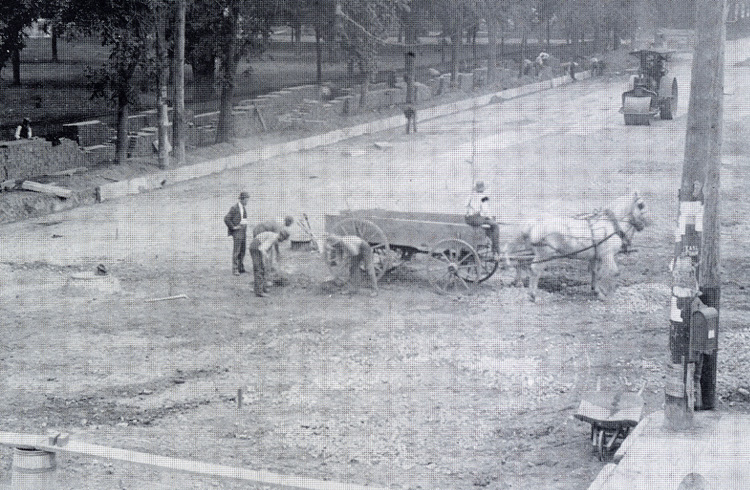
Photo
by Laurence Welsh courtesy of Paul Welsh
The
first street paving project in Iowa City is underway in this 1895 image
looking north
along Clinton Street from Washington Street with the Pentacrest Campus as a
backdrop.
The surface from Jefferson south to Burlington was brick, which can be seen
stacked at
street side beyond a limestone curb already in place.
|
By
Bob Hibbs
Pedestrian
“boardwalks” downtown began lifting Iowa City from mud more than 150 years
ago, a process which later encompassed vehicle routes of gravel, macadam,
brick, concrete and asphalt.
Judge
George Wright reportedly asked a stagecoach driver in 1840 how long it would
take to travel a final 12 miles into Iowa City. “About five hours,” the
driver reportedly replied, “if we can find the bottom of the road.”
Although
local pioneers believed county and state authorities provided enough
government, terrible local street conditions were a key factor which finally
fostered a city government in 1853. Among the new council’s first actions
was appointing a commissioner charged with maintaining and improving streets.
As
late as 1922, after watching Iowa defeat Minnesota 28-14 during its homecoming
game of a second consecutive undefeated season, Iowa football fans faced
traveling home during a fierce rainstorm. Some 500 cars were reported stranded
in mud just between North Liberty and Cedar Rapids.
The
most fortunate hopped an Interurban rail car for a hotel either in Cedar
Rapids or back in Iowa City.
Hundreds
spent the night in their cars. Next day, one farmer reported collecting $90 in
just two hours pulling cars from the mud. He was among many who earned a
Chicago Tribune headline: “Autos Stick in Iowa Muck; Gold Harvest in
Iowa,” reports William Petersen in the February 1965 issue of Palimpsest
magazine.
Pedestrians
got first attention, with wood planks in front of stores downtown.
On
Pentacrest, coal tar produced locally was mixed with sand to run a walk from
Old Capitol to South and North halls during the Civil War era, but that
material proved unsatisfactory and tracked into buildings. The walks were
replaced in 1876 by limestone from a quarry at Joliet, Ill, reports Margaret
Keyes in a 1988 Old Cap history.
Once
street brick paving was installed on Clinton Street between Jefferson and
Burlington in 1895, demand exploded. Built for a horse and buggy era, that
strip was extended in 1897 north to Church and south to Harrison; then, by two
more blocks to the Rock Island depot the following year.
Before
that first burst subsided, College was bricked east to Summit in 1897, and
Summit was paved south to Bowery Street. Then, a decade passed before paving
was extended from the downtown north on Linn to Brown, then east along Brown
to Oakland and St. Joseph’s cemeteries.
That
same year of 1907 also brought paving of Iowa Avenue from Clinton to Gilbert,
which was extended to Muscatine Avenue the next summer. Dubuque Street was
paved in 1914 north from the downtown to the Park Road bridge, except for the
center 10 feet occupied by trolley tracks.
In
Iowa’s rural areas, multiple jurisdictions impeded progress for decades. A
state highways department was established in 1904 as an adjunct of the
engineering college at Iowa State in Ames. But, it took the arrival of federal
highway dollars in 1916 to invigorate the move to paving.
When
the 1920s produced a federal requirement that a state control federal routes
before it used federal aid, the paving of transcontinental routes soon was
seriously underway. Iowa built more than 2,300 miles of paving during the
1920s, and 2,800 miles the following decade.
By
1927 Iowa City had its first highway paving of about five miles of the
River-to-River Route (later Highway 6) out through the tiny village of
Coralville, plus a three-mile stretch of what then was the Red Ball Route
(later old Highway 218) out North Dubuque Street across Butler bridge to near
what is now River Heights.
The
area’s other “highways” all still were dirt in 1927, a fact that changed
dramatically during the subsequent two decades.
The
last local paving was Interstate 80 opened on Iowa City’s northern boundary
in 1963.
Next
Saturday:
Coal gas lights Iowa City in 1857; natural gas 1936. Bob Hibbs collects local postcards and researches history related to them.
|